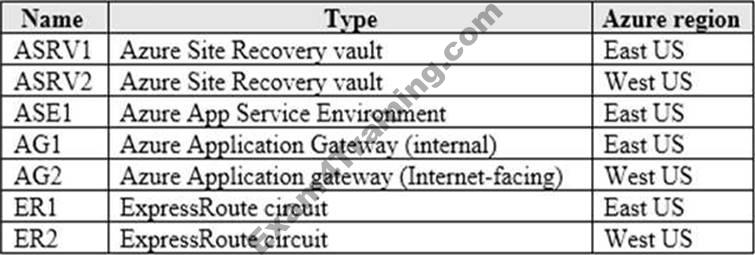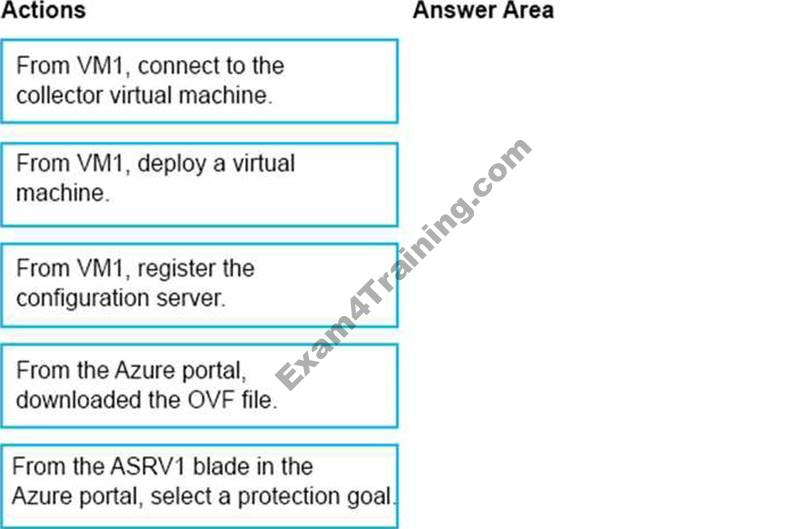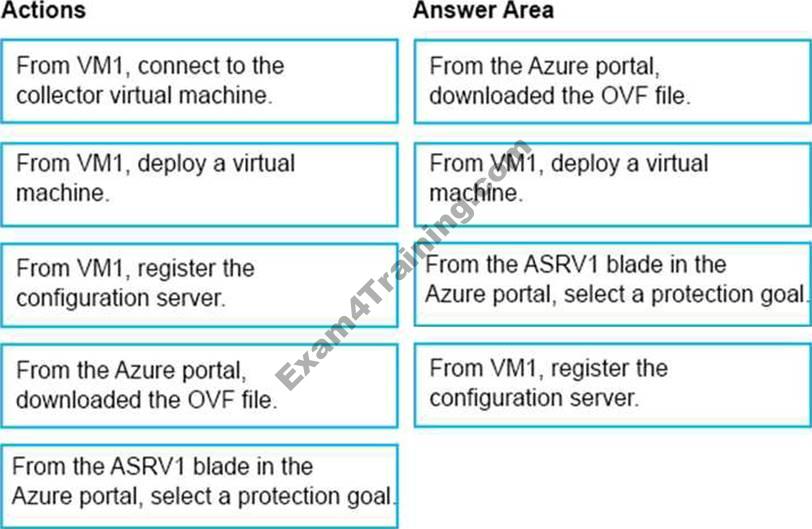Which four actions you perform in sequence?
Case Study: 5
A Datum Corporation
Overview
ADatum Corporation is a financial company that has two main offices in New York and Los Angeles. ADatum has a subsidiary named Fabrikam, Inc. that shares the Los Angeles office.
ADatum is conducting an initial deployment of Azure services to host new line-of-business applications and is preparing to migrate its existing on-premises workloads to Azure.
ADatum uses Microsoft Exchange Online for email. On-Premises Environment
The on-premises workloads run on virtual machines hosted in a VMware vSphere 6 infrastructure. All the virtual machines are members of an Active Directory forest named adatum.com and run Windows Server 2016.
The New York office an IP address of 10.0.0.0/16. The Los Angeles office uses an IP address space of 10.10.0.0/16.
The offices connect by using a VPN provided by an ISP. Each office has one Azure ExpressRoute circuit that provides access to Azure services and Microsoft Online Services. Routing is implemented by using Microsoft peering.
The New York office has a virtual machine named VM1 that has the vSphere console installed. Azure Environment
You provision the Azure infrastructure by using the Azure portal.
The infrastructure contains the resources shown in the following table.

AG1 has two backend pools named Pool11 and Pool12. AG2 has two backend pools named Pool21 and Pool22.
Planned Changes
ADatum plans to migrate the virtual machines from the New York office to the East US Azure region by using Azure Site Recovery.
Infrastructure Requirements
ADatum identifies the following infrastructure requirements:
– A new web app named App1 that will access third-parties for credit card processing must be deployed.
– A newly developed API must be implemented as an Azure function named App2. App2 will use a blob storage trigger. App2 must process new blobs immediately.
– The Azure infrastructure and the on-premises infrastructure and the on-premises infrastructure must be prepared for the migration of the VMware virtual machines to Azure.
– The sizes of the Azure virtual machines that will be used to migrate the on-premises workloads must be identified.
– All migrated and newly deployed Azure virtual machines must be joined to the adatum.com domain.
– AG1 must load balance incoming traffic in the following manner:
– http://corporate.adatum.com/video/* will be load balanced across Pool11.
– http://corporate.adatum.com/images/* will be load balanced across Pool12.
– AG2 must load balance incoming traffic in the following manner:
– http://www.adatum.com will be load balanced across Pool21.
– http://www.fabrikam.com will be load balanced across Pool22.
– ER1 must route traffic between the New York office and the platform as a service (PaaS)
services in the East US Azure region, as long as ER1 is available.
– ER2 must route traffic between the Los Angeles office and the PaaS sevices in the West US
region, as long as ER2 is available.
– ER1 and ER2 must be configured to fail over automatically.
Application Requirements
App2 must be able to connect directly to the private IP addresses of the Azure virtual machines. App2 will be deployed directly to an Azure virtual network.
Inbound and outbound communications to App1 must be controlled by using NSGs.
Pricing Requirements
ADatum identifies the following pricing requirements:
– The cost of App1 and App2 must be minimized.
– The transactional charges of Azure Storage account must be minimized.
DRAG DROP
You need to prepare the New York office infrastructure for the migration of the on-premises virtual
machines to Azure.
Which four actions you perform in sequence? To answer, move the appropriate actions from the list of actions to the answer area and arrange them in the correct order.

Answer: 
Explanation:
Box 1:
– From the Azure portal, download the OVF file.
– In the vCenter Server, import the Collector appliance as a virtual machine using the Deploy OVF Template wizard.
– In vSphere Client console, click File > Deploy OVF Template.
– In the Deploy OVF Template Wizard > Source, specify the location for the .ovf file.
Box 2: From VM1, connect to the collector virtual machine
After you’ve created the Collector virtual machine, connect to it and run the Collector.
Box 3: From the ASRV1 blade in the Azure portal, select a protection goal.
Box 4: From VM1, register the configuration server.
Register the configuration server in the vault
Scenario: The Azure infrastructure and the on-premises infrastructure and the on-premises infrastructure must be prepared for the migration of the VMware virtual machines to Azure. References:
Migrate Your Virtual Machines to Microsoft Azure, Includes guidance for optional data migration, Proof of Concept guide, September 2017 https://azuremigrate.blob.core.windows.net/publicpreview/Azure%20Migrate%20-
%20Preview%20User%20Guide.pdf
Latest AZ-103 Dumps Valid Version with 369 Q&As
Latest And Valid Q&A | Instant Download | Once Fail, Full Refund

